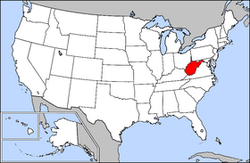The West Virginia Secondary School Activities Commission (WVSSAC, but colloquially referred to as SSAC) is the main governing body of high school sports, cheerleading, and marching bands in West Virginia, United States. Beginning with the 2024-25 school year the Commission adopted a new system of four classes. Unlike the previous system, and the systems used in most other states, it is based on an algorithm where the population is 80%, the distance from a town of 10,000 people is 10%, and the median income of the parents is 10%. This system is used for football, cheerleading, basketball, and baseball/softball. Golf, cross country, track and field, are broken into 3 classes. Soccer and wrestling, are two classes. Swimming is one class only. [1]
 | |
| Abbreviation | WVSSAC |
|---|---|
| Type | Volunteer; NPO |
| Legal status | Association |
| Purpose | Athletic/Educational |
| Headquarters | 2875 Staunton Turnpike Parkersburg, WV 26104 |
Region served | West Virginia |
Official language | English |
Executive Director | David Price |
| Affiliations | National Federation of State High School Associations |
Staff | 4 |
| Website | wvssac.org |
| Remarks | (304) 485-5494 |
The organization began with boys' basketball championships in 1914. During the decades of segregated schools in West Virginia, it excluded schools for African American students. They competed in the West Virginia Athletic Union. The organization excluded private schools until 1979, when it merged with the state Catholic League. Today it also includes private schools of various religious viewpoints, along with all public schools in the state.
Unlike similar governing bodies in the United States, the WVSSAC does not dictate individual high school schedules during the regular season; those decisions are made by the coaches involved. Note that the WVSSAC does set forth some basic guidelines (i.e., the number of schools within its own classification or higher that a school must compete against) for a school to be eligible for that sport's playoffs. The WVSSAC determines scheduling during the playoffs. For example, in football, whose playoffs are seeded on a statewide basis, each game is played at the higher-seeded school's campus if its stadium is approved by the SSAC to host playoff matches. Otherwise, it is played at the SSAC-approved venue nearest to the higher-seeded school. The lower-seeded school has the choice of one of three starting times — 7:30 pm on Friday or Saturday, or 1:30 pm on Saturday.[2]
Activities
edit- Band
- Baseball – Appalachian Power Park, Charleston
- Basketball – Charleston Civic Center, Charleston
- Cheerleading – Charleston Civic Center, Charleston
- Cross country – Cabell Midland High School, Ona
- Football – Laidley Field, Charleston[3]
- Golf (site changes from year to year)
- Soccer – YMCA, Beckley
- Softball – Little Creek Park South Charleston[4]
- Swimming – West Virginia University, Morgantown
- Tennis – Watt Powell Tennis Annex and Player's Club Tennis Center, Charleston
- Track – Laidley Field, Charleston
- Volleyball– Charleston Civic Center, Charleston
- Wrestling– Marshall Health Network Arena, Huntington
Controversies
editPrior to the decision in Brown v. Board of Education, West Virginia maintained "colored" high schools.[5] These schools, and thus their students, were barred from competition in the WVSSAC. The institution now known as West Virginia State University funded an unofficial "state colored championship" in basketball and football until 1959. The WVSSAC historical records take no note of these champions, and does not note that its champions prior to that year competed in a system that excluded many of the state's best athletes.
West Virginia was one of only three states to hold girls' basketball in the fall, and girls' volleyball in the winter, ostensibly due to facility shortages at various high schools. Eventually the West Virginia Supreme Court of Appeals ruled that this unfairly disadvantaged girls in competition for college scholarships and the organization was forced to adopt a traditional schedule.
There also were complaints that the disparity of enrollment in the old Class AAA made it difficult for the smaller schools in the classification to compete, particularly in football. There was a 1032 student difference between Cabell Midland and Ripley, Cabell Midland being the largest and Ripley being the smallest schools in the class respectively, at that time. On the other hand, there wass only a 473 student difference between Ripley and the smallest Class AA school, Man. The last time a AAA school with an enrollment under 1000 students won a football championship was Nitro in 1998. In the 2016 re-class the number of AAA schools was reduced in order to reduce the disparity in enrollment. The 2024 algorithm system and moving to four classes was also used, in part, to ease the disparity between school enrollment size.
Multiple schools appealed the new for 2024 classification system, mostly claiming that the metric of distance to a town of 10,000 was misapplied. Ultimately 22 schools were classified down by the Board of Review, leaving only 16 teams in Class AAAA, at least for the 2024 season. [6]
References
edit- ^ Rather, Joey (2023-12-21). "WVSSAC approves four-class system for high school sports". www.wboy.com.
- ^ "2006 Football Playoff Manual" (PDF). West Virginia Secondary School Activities Commission. Retrieved 2007-08-22.
- ^ "Charleston earns rights to host the WVSSAC Football Championships". 22 February 2024.
- ^ "2024 WVSSAC State Softball Tournament schedule". 16 May 2024.
- ^ "Celebrating the Athletic Union".
- ^ "Eleven more schools reclassified by WVSSAC for 2024 football season".